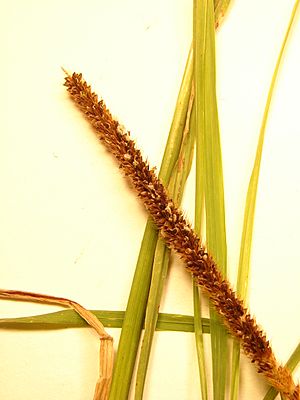Setaria sphacelata facts for kids
Quick facts for kids Setaria sphacelata |
|
|---|---|
 |
|
| Scientific classification | |
| Genus: |
Setaria
|
| Species: |
sphacelata
|
| Synonyms | |
|
|
Setaria sphacelata is a tall grass from Africa. It is also known as South African pigeon grass or African bristlegrass. This plant grows naturally in warm parts of Africa. People around the world grow it to feed farm animals. It is used both as pasture (where animals graze) and for hay (cut and dried grass).
This grass is a perennial, meaning it grows back every year. It has underground stems called rhizomes. Its flat, smooth, blue-green stems can grow up to 2 meters (about 6.5 feet) tall. The flower head, called an inflorescence, looks like a dense, narrow brush. It has bristly, orange-colored seeds and can be up to 25 centimeters (about 10 inches) long.
Contents
What is Setaria Sphacelata?
Setaria sphacelata is a type of grass that is very important in many places. It is known for its height and its ability to grow well in different conditions. Farmers often choose this grass because it provides good food for their livestock.
Where Does This Grass Grow?
This grass is originally from the tropical and subtropical regions of Africa. This means it likes warm climates. However, because it is so useful, it has been planted in many other countries too. It can now be found growing in various parts of the world.
How Does It Help Animals?
In Africa, the seeds of Setaria sphacelata are a key food source for many birds. One example is the long-tailed widowbird. This shows how important the grass is to local wildlife.
For farm animals like cattle, sheep, and goats, Setaria sphacelata is a good quality food. It can be fed to them fresh, or it can be stored as silage. Silage is fermented grass that can be kept for a long time.
Growing Setaria Sphacelata
Farmers have developed special types of this grass, called cultivars. These cultivars are bred to grow best in different climates and soil types. This helps farmers choose the right grass for their specific needs.
Important Things to Know When Growing
All types of Setaria sphacelata contain a substance called oxalate. Because of this, it is generally not suitable for horses. Oxalate can be harmful to horses if they eat too much of it.
Like other plants, Setaria sphacelata can face problems from pests and diseases. Some known pests include the buffel grass seed caterpillar. A fungus called Pyricularia trisa can also affect the grass. Farmers need to manage these issues to keep their crops healthy.
Setaria Sphacelata as an Invasive Plant
While Setaria sphacelata is useful for farming, it can also cause problems. In many countries where it was introduced, it has become naturalised. This means it now grows on its own outside of farms.
Impact on the Environment
In some places, like three states in Australia, Setaria sphacelata has become an environmental weed. An environmental weed is a plant that spreads aggressively and harms native plants and ecosystems. It can take over areas, reducing the variety of plants that naturally grow there.

